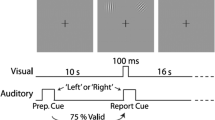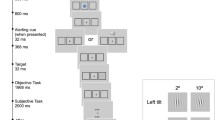Abstract
It has been proposed that the right hemisphere alerting network co-activates, either directly or via the brainstem, the attention system in the parietal cortex involved in spatial attention. The observation that impaired alertness and sustained attention can predict the outcome of neglect might suggest such a relationship, too. In the present fMRI study, we intended to analyse and compare the functional anatomy of two attentional conditions both involving intrinsic (endogenous) alerting and fixation but differing with respect to the degree of spatially distributed attention by using the same paradigm under two different attentional conditions. In a group of ten participants, both a focused and a distributed visuospatial attention condition evoked similar patterns of activation in dorsolateral prefrontal regions, in the anterior cingulate gyrus, in the superior and inferior parietal cortex as well as in the superior temporal gyrus and in the thalamus. These activation foci were stronger in the right hemisphere under both conditions. After subtraction of the alertness condition with focused spatial attention, distributed spatial attention with stimuli appearing at unpredictable locations within both visual fields induced additional bilateral activations only in the left and right superior parietal cortex and in the right precuneus suggesting that these regions are specific for a more widespread dispersion of spatial attention.



Similar content being viewed by others
References
Ashburner J, Friston KJ (1999) Nonlinear spatial normalization using basis functions. Hum Brain Mapping 7:254–266
Corbetta M (1998) Frontoparietal cortical networks for directing attention and the eye to visual locations:identical, independent, or overlapping neural systems?. Proc Nat Acad Sci USA 95:831–838
Corbetta M, Shulman GL (2002) Control of goal-directed and stimulus-driven attention in the brain. Nat Rev Neurosci 3:201–215
Corbetta M, Miezin FM, Shulman GL, Petersen SE (1993) A PET study of visuospatial attention. J Neurosci 13:1202–1226
Corbetta M, Shulman GL, Miezin FM, Petersen SE (1995) Superior parietal cortex activation during spatial attention shifts and visual feature conjunction. Science 270:802–805
Corbetta M, Akbudak E, Conturo TE, Snyder AZ, Ollinger JM, Drury HA, Linenweber MR, Petersen SE, Raichle ME, van Essen DC, Shulman GL (1998) A common network of functional areas for attention and eye movements. Neuron 21:761–773
Corbetta M, Kincade JM, Ollinger JM, McAvoy MP, Shulman GL (2000) Voluntary orienting is dissociated from target detection in human posterior parietal cortex. Nat Neurosci 3:292–297
Coull JT, Frith CD, Frackowiak RS, Grasby PM (1997) A fronto-parietal network for rapid visual information processing:a PET study of sustained attention and working memory. Neuropsychologia 34:1085–1095
Coull JT, Nobre AC, Frith CD (2001) The noradrenergic alpha2 agonist clonidine modulates behavioural and neuroanatomical correlates of human attentional orienting and alerting. Cerebr Cortex 11:73–84
Fernandez-Duque D, Posner MI (1997) Relating the mechanisms of orienting and alerting. Neuropsychologia 35:477–486
Fink GR, Marshall JC, Shah NJ, Weiss PH, Halligan PW, Grosse-Ruyken M, Ziemons K, Zilles K, Freund HJ (2000) Line bisection judgments implicate right parietal cortex and cerebellum as assessed by fmri. Neurol 54:1324–1331
Friston KJ, Jezzard P (1994) Analysis of functional MRI time-series. Hum Brain Map 1:153–171
Friston KJ, Frith CD, Turner R, Frackowiak RS (1995a) Characterizing evoked hemodynamics with fmri. NeuroImage 2:157–165
Friston KJ, Holmes AP, Poline JB, Grasby PJ, Williams SC, Frackowiak RS, Turner R (1995b) Analysis of fmri time-series revisited. NeuroImage 2:45–53
Friston KJ, Holmes A, Poline JB, Price CJ, Frith CD (1996) Detecting activations in PET and fmri: levels of inference and power. NeuroImage 4:223–235
Friston KJ, Holmes AP, Worsley KJ (1999) How many subjects constitute a study? NeuroImage 10:1–5
Heinze HJ Mangun GR, Burchert W, Hinrichs H, Scholz M, Münte TF, Gös A, Scherg M, Johannes S, Hundeshagen H, Gazzaniga MS, Hillyard SA (1994) Combined spatial and temporal imaging of brain activity during visual selective attention in humans. Nature 372:543–546
Hjaltason H, Tegner R, Tham K, Levander M, Ericson K (1996) Sustained attention and awareness of disability in chronic neglect. Neuropsychologia 34:1229–1233
Howes D, Boller F (1975) Simple reaction time:evidence for focal impairment from lesions of the right hemisphere. Brain 98:317–332
Karnath HO (1997) Spatial orientation and the representation of space with parietal lobe lesions. Philos Trans R Soc Lond B Biol Sci 352:1411–1419
Kim YH, Gitelman DR, Nobre AC, Parrish TB, LaBar KS, Mesulam MM (1999) The large-scale neural network for spatial attention displays multifunctional overlap but differential asymmetry. NeuroImage 9:269–277
Kincade JM, Abrams RA, Astafiev SV, Shulman GA, Corbetta M (2005) An event-related functional magnetic resonance imaging study of voluntary and stimulus-driven orienting of attention. J Neurosci 25:4593–4604
Kinomura S, Larsson J, Gulyas B, Roland PE (1996) Activation by attention of the human reticular formation and thalamic intralaminar nuclei. Science 271:512–515
Kinsbourne M (1983) Orientational bias model of unilateral neglect: evidence from attentional gradients within hemispace. In: Robertson IH, Marshall JC (eds) Unilateral neglect: clinical and experimental studies. Lawrence Erlbaum, Hillsdale, pp 63–86
LaBerge D Buchsbaum MS (1990) Positron emission tomographic measurements of pulvinar activity during an attention task. J Neurosci 10:613–619
Ladavas E (1987) Is the hemispatial deficit produced by right parietal lobe damage associated with retinal or gravitational coordinates?. Brain 110:167–180
Law I, Svarer C, Holm S, Paulson OB (1997) The activation pattern in normal humans during suppression, imagination and performance of saccadic eye movements. Acta Physiol Scand 161:419–434
Luks TL, Simpson GV, Feiwell RJ, Miller WL (2002) Evidence for anterior cingulate cortex involvement in monitoring preparatory attentional set. Neuroimage 17:792–802
Murtha S, Beauregard M, Dixon R, Evans A (1996) Hypotheses about the role of the anterior cortex (ACC). Human Brain Mapping 4:103–112
Nobre AC, Sebestyen GN, Gitelman DR, Mesulam MM, Frackowiak RS, Frith CD (1997) Functional localization of the system for visuospatial attention using positron emission tomography. Brain 120:515–533
Paus T, Zatorre RJ, Hofle N, Caramanos Z, Gotman J, Petrides ME, vans A (1997) Time-related changes in neural systems underlying attention and arousal during the performance of an auditory vigilance task. J Cogn Neurosci 9:392–408
Paus T, Koski L, Caramanos Z, Westbury C (1998) Regional differences in the effects of task difficulty and motor output on blood flow response in the human anterior cingulate cortex: a review of 107 PET activation studies. NeuroReport 9:R37–R47
Pessoa L, Kastner S, Ungerleider LG (2003) Neuroimaging studies of attention: From modulation of sensory processing to top-down control. J Neurosci 23:3990–3998
Petit L, Tzourio N, Orssaud C, Pietrzyk U, Berthoz A, Mazoyer B (1995) Functional neuroanatomy of the human visual fixation system. Eur J Neurosci 7:169–174
Posner MI (1975) The psychobiology of attention. In: Gazzaniga M, Blakemore C (eds) Handbook of psychobiology. Academic, New York, pp 441–480
Posner MI (1978) Chronometric explorations of mind. Erlbaum, Hillsdale
Posner MI, Petersen SE (1990) The attention system of the human brain. Ann Rev Neurosci 13:25–42
Posner MI, Walker JA, Friedrich FJ, Rafal RD (1984) Effects of parietal injury on covert orienting of attention. J Neurosci 4:1863–1874
Posner MI, Inhoff AW, Friedrich FJ (1987) Isolating attentional systems: a cognitive-anatomical analysis. Psychobiol 15:107–121
Rizzolatti G, Riggio L, Dascola I, Umilta C (1987) Reorienting attention across the horizontal and vertiocal meridians: evidence in favor of a premotor theory of attention. Neuropsychologia 24:31–40
Robertson IH (1993) The relationship between lateralised and nonlateralised attentional deficits in unilateral neglect. In: Robertson IH, Marshall JC (eds) Unilateral neglect: clinical and experimental studies. Lawrence Erlbaum Associates, Hove, pp 257–278
Robertson I, Frasca R (1992) Attentional load and visual neglect. Int J Neurosci 62:45–56
Robertson IH, Tegner R, Tham K, Lo A, Nimmo-Smith I (1995) Sustained attention training for unilateral neglect: theoretical and rehabilitation implications. J Clin Exp Neuropsychol 17:416–430
Robertson IH, Manly T, Beschin N, Daini R, Haeske-Dewick H, Homberg V, Jehkonen M, Pizzamiglio G, Shiel A, Weber E (1997a) Auditory sustained attention is a marker of unilateral spatial neglect. Neuropsychologia 35:1527–1532
Robertson IH, Ridgeway V, Greenfield E, Parr A (1997b) Motor recovery after stroke depends on intact sustained attention: a 2-year follow-up study. Neuropsychology 11:290–295
Robertson IH, Mattingley JB, Rorden C, Driver J (1998) Phasic alerting of neglect patients overcomes their spatial deficit in visual awareness. Nature 395:169–172
Robinson RG (1985) Lateralized behavioral and neurochemical consequences of unilateral brain injury in rats. In: Glick SG (eds) Cerebral lateralization in nonhuman species. Academic, Orlando, pp 135–156
Robinson RG, Coyle JT (1980) The differential effect of right versus left hemispheric cerebral infarction on catecholamines and behavior in the rat. Brain Res 188:63–78
Samuelsson H, Hjelmquist EK, Jensen C, Ekholm S, Blomstrand C (1998) Nonlateralized attentional deficits: an important component behind persisting visuospatial neglect? J Clin Exp Neuropsychol 20:73–88
Sturm W, Willmes K (2001) On the functional neuroanatomy of intrinsic and phasic alertness. Neuroimage 14:76–84
Sturm W, de Simone A, Krause BJ, Specht K, Hesselmann V, Radermacher I, Herzog H, Tellmann L, Muller-Gartner HW, Willmes K (1999) Functional anatomy of intrinsic alertness: evidence for a fronto-parietal-thalamic-brainstem network in the right hemisphere. Neuropsychologia 37:797–805
Sturm W, Longoni F, Fimm B, Dietrich T, Weis S, Kemna S, Herzog H, Willmes K (2004). Network for auditory intrinsic alertness: a PET study. Neuropsychologia 42:563–568
Talairach J, Tournoux P (1988) Co-planar stereotactic atlas of the human brain. Thieme, Stuttgart
Thiel CM, Zilles K, Fink GR (2004) Cerebral correlates of alerting, orienting and reorienting of visuospatial attention: an event-related fMRI study. Neuroimage 21:318–328
Vallar G (1993) The anatomical basis of spatial hemineglect in humans. In: Robertson IH, Marshall JC (eds) Unilateral neglect: clinical and experimental studies. Lawrence Erlbaum Associates, Hove, pp 27–62
Vallar G, Perani D (1986) The anatomy of unilateral neglect after right-hemisphere stroke lesions A clinical/CT-scan correlation study in man. Neuropsychologia 24:609–622
Vandenberghe R, Dupont P, De Bruyn B, Bormans G, Michiels J, Mortelmans L, Orban GA (1996) The influence of stimulus location on the brain activation pattern in detection and orientation discrimination A PET study of visual attention. Brain 119:1263–1276
Vandenberghe R, Duncan J, Dupont P, Ward R, Poline JB, Bormans G, Michiels J, Mortelmans L (1997) Attention to one or two features in left or right visual field: a positron emission tomography study. J Neurosci 17:3739–3750
Whitehead R (1991) Right hemisphere processing superiority during sustained visual attention. J Cogn Neurosci 3:329–335
Worsley K J, Friston K J (1995) Analysis of fMRI time-series revisited–again. Neuroimage 2:173–181
Yantis S, Schwarzbach J, Serences JT, Carlson RL, Steinmetz MA, Pekar JJ, Courtney SM (2002) Transient neural activity in human parietal cortex during spatial attention shifts. Nat Neurosci 5:995–1002
Zimmermann P, Fimm B (1997) Handbuch der Testbatterie zur Aufmerksamkeitsprüfung. Psytest, Freiburg
Acknowledgments
The study was supported by a grant from the Medical Faculty of the RWTH Aachen University within the Interdisciplinary Clinical Research Center “CNS”. We thank Stephan Erberich and Manou Liebert for assistance with data acquisition, image data processing and statistical analyses.
Author information
Authors and Affiliations
Corresponding author
Rights and permissions
About this article
Cite this article
Sturm, W., Schmenk, B., Fimm, B. et al. Spatial attention: more than intrinsic alerting?. Exp Brain Res 171, 16–25 (2006). https://doi.org/10.1007/s00221-005-0253-1
Received:
Accepted:
Published:
Issue Date:
DOI: https://doi.org/10.1007/s00221-005-0253-1




